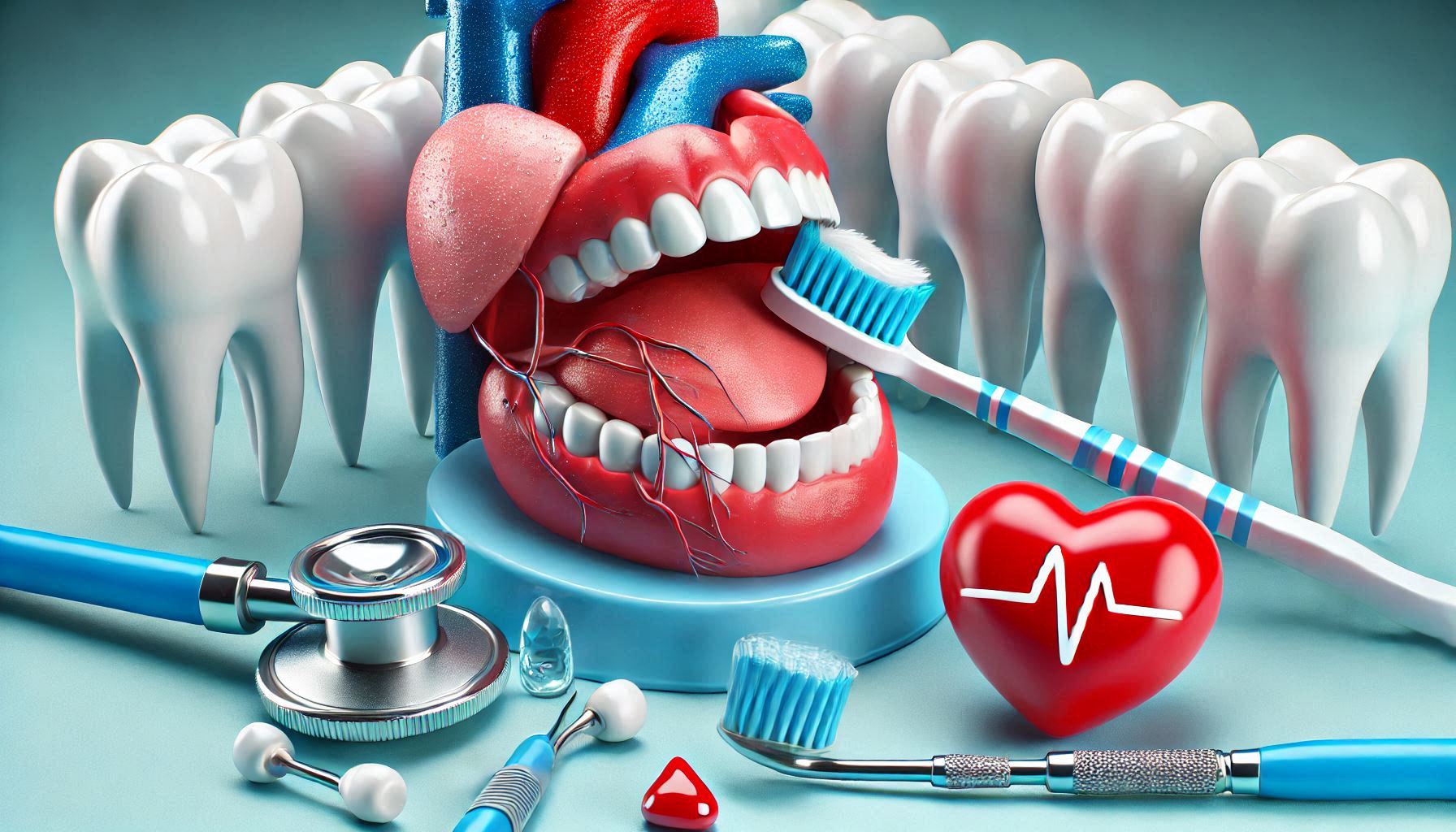For most people, the primary concern with gum disease is the effect it has on their oral health — bad breath, bleeding gums, or even tooth loss. However, a growing body of scientific research is revealing that the dangers of gum disease extend far beyond the mouth. In recent years, a mounting body of evidence has shed light on a potential link between periodontal disease and cardiovascular problems, particularly heart disease. Studies suggest that individuals suffering from gum disease are at an increased risk for developing a range of serious heart-related conditions. This revelation is startling for many, as it highlights the importance of not just caring for your teeth and gums, but also maintaining an overall healthy lifestyle to reduce the risk of life-threatening cardiovascular conditions.
This guide will provide an in-depth exploration of the intricate relationship between gum disease and heart disease. We will delve into the underlying mechanisms that connect oral infections to cardiovascular risks, examine the scientific evidence supporting these findings, and look at the practical implications for maintaining oral and heart health. From understanding the nature of gum disease to analyzing research findings, we will uncover why gum disease should be viewed as more than just a dental concern. It is a critical health issue that can have far-reaching consequences for the rest of the body, particularly the heart.
The Nature of Gum Disease
To understand how gum disease can affect heart health, we first need to thoroughly examine what gum disease is, how it develops, and why it’s important to treat it early. Gum disease, or periodontal disease, is a group of inflammatory conditions that affect the tissues surrounding the teeth. It begins with gingivitis and can progress into more severe forms like periodontitis if left untreated.
Gingivitis: The Early Warning Sign
Gingivitis is the initial stage of gum disease and is primarily caused by the accumulation of plaque—a sticky film of bacteria that forms on the teeth and gums. When plaque is not removed by regular brushing and flossing, it can irritate the gums, causing them to become red, swollen, and bleed, especially when brushing or flossing. Gingivitis is relatively common and can affect anyone, but it is easily treatable with good oral hygiene practices such as brushing twice a day, flossing, and professional dental cleanings.
Though gingivitis is considered mild and reversible, it’s often ignored by individuals who do not experience pain or other more obvious symptoms. If left untreated, however, gingivitis can develop into a more serious and potentially damaging condition known as periodontitis.
Periodontitis: The Progression of Gum Disease
Periodontitis is a more advanced and severe form of gum disease. If gingivitis goes untreated, the infection spreads deeper into the gums and affects the bone structures that support the teeth. The gums may recede, forming pockets that trap more bacteria, which causes further damage. The body’s immune response to this infection leads to chronic inflammation, which, over time, can weaken the bone and connective tissue, ultimately resulting in tooth loss.
In periodontitis, the effects are not just confined to the mouth; the chronic inflammation can spread throughout the body, affecting organs and systems beyond the oral cavity. This is where the potential link to heart disease becomes more relevant. Research suggests that the same inflammatory processes that damage gum tissue can also increase the risk of cardiovascular diseases.
Risk Factors for Gum Disease
Several risk factors increase the likelihood of developing gum disease. These include poor oral hygiene, smoking, genetics, diabetes, certain medications, and a poor diet. Understanding these risk factors is critical in both preventing and treating gum disease. Lifestyle choices, particularly smoking and poor dietary habits, are linked to a greater incidence of gum disease and, as we will explore later, these same factors can also exacerbate heart disease risk.
Additionally, underlying health conditions such as diabetes, autoimmune disorders, and HIV/AIDS can increase the likelihood of gum disease due to the effects these conditions have on immune function. For example, diabetes leads to a higher glucose concentration in the saliva, which can make it easier for bacteria to thrive in the mouth, leading to gingivitis and periodontitis.
The Inflammation Link Between Gum Disease and Heart Disease
The relationship between gum disease and heart disease revolves primarily around inflammation. Chronic inflammation is a recognized risk factor for a variety of cardiovascular conditions, including coronary artery disease, stroke, and heart attacks. While inflammation typically serves as a natural defense mechanism by helping the body fight off infections, when it becomes prolonged and systemic, it can lead to serious health problems.
The Role of Inflammation in Gum Disease
In response to the bacterial infection in the gums caused by plaque buildup, the immune system releases pro-inflammatory molecules, including cytokines and prostaglandins. These molecules are intended to combat the infection by signaling the body to activate its immune response. While this is beneficial in the short term, prolonged inflammation caused by ongoing gum infection can have damaging effects on the body.
Gum disease triggers a chronic low-grade inflammatory state that circulates through the bloodstream. This systemic inflammation can contribute to the development of atherosclerosis, the buildup of fatty deposits inside the arteries. Over time, atherosclerosis can cause the arteries to become narrowed and stiff, limiting blood flow to vital organs and increasing the risk of heart disease.
How Inflammation from Gum Disease Affects Cardiovascular Health
The inflammatory molecules released during gum disease have the potential to travel through the bloodstream, where they may affect blood vessels and the heart. These inflammatory substances can interfere with the normal function of endothelial cells, which line blood vessels and play an essential role in regulating blood flow and preventing clot formation. This disruption, known as endothelial dysfunction, is a key factor in the development of atherosclerosis and cardiovascular diseases.
Moreover, inflammation has been shown to increase the production of C-reactive protein (CRP), a blood marker used to assess inflammation in the body. Elevated CRP levels are associated with an increased risk of cardiovascular events, including heart attacks and strokes. Individuals with gum disease often have elevated CRP levels, making it one of the reasons why gum disease is considered a risk factor for heart disease.
The Impact of Systemic Inflammation on the Cardiovascular System
Systemic inflammation can accelerate the process of plaque formation in the arteries. Over time, this plaque hardens and narrows the arteries, a condition known as atherosclerosis. Atherosclerosis reduces the ability of blood to flow freely through the heart, brain, and other organs, which can increase the likelihood of dangerous cardiovascular events such as heart attacks and strokes.
Research indicates that people with periodontitis have a higher concentration of systemic inflammatory markers, including CRP and interleukin-6 (IL-6), both of which are strongly linked to cardiovascular disease. Furthermore, the chronic inflammation associated with gum disease may also exacerbate existing heart conditions, compounding the risks for individuals who already have a history of cardiovascular problems.
Bacterial Pathways: How Oral Bacteria Can Reach the Heart
The second major way in which gum disease may contribute to heart disease is through the presence of bacteria in the mouth. The mouth is home to millions of bacteria, most of which are harmless when maintained in a healthy environment. However, when gum disease is present, the balance of bacteria in the mouth is disrupted, allowing harmful bacteria to proliferate.
Bacteria in the Bloodstream: A Direct Pathway to Heart Disease
When gum disease progresses, it can lead to the creation of small pockets in the gums, which act as entry points for harmful bacteria. These bacteria can enter the bloodstream through tiny cuts or openings in the gum tissue caused by brushing, flossing, or even chewing. Once in the bloodstream, these bacteria can travel to various parts of the body, including the heart.
Some species of oral bacteria, such as Porphyromonas gingivalis, Tannerella forsythia, and Treponema denticola, have been implicated in the development of cardiovascular disease. These bacteria can contribute to the formation of plaques in the arteries, a condition known as atherosclerosis. Furthermore, the bacteria themselves may trigger an inflammatory response in the cardiovascular system, exacerbating the damage caused by atherosclerosis.
The Role of Blood Clots in Heart Disease
In addition to contributing to the formation of arterial plaques, oral bacteria may also play a role in the formation of blood clots. Some oral bacteria produce toxins that can increase the tendency of blood to clot. This can lead to the formation of thrombi, or blood clots, which can block blood flow to the heart or brain, leading to heart attacks or strokes.
For people with gum disease, the risk of blood clot formation is heightened due to the combination of arterial plaque buildup and the presence of oral bacteria in the bloodstream. This dual threat increases the risk of cardiovascular events and highlights the importance of maintaining good oral hygiene to reduce the presence of harmful bacteria.
Epidemiological Evidence: Studies Linking Gum Disease and Heart Disease
A large number of studies have explored the connection between gum disease and heart disease, with many indicating a significant association between the two. While the exact mechanism remains a subject of ongoing research, the epidemiological evidence is compelling.
The American Heart Association’s Findings
The American Heart Association (AHA) has recognized the potential link between gum disease and heart disease. Although the AHA stopped short of declaring that gum disease directly causes heart disease, the association has acknowledged the growing body of evidence linking periodontal disease with an increased risk of cardiovascular problems.
In 2012, the AHA issued a statement that noted the presence of periodontal disease as a potential risk factor for heart disease. The statement emphasized the need for further studies to explore the link more fully but highlighted the importance of good oral hygiene in reducing the risk of both gum disease and heart disease.
Key Research Studies
Several significant studies have explored the relationship between periodontal disease and cardiovascular disease. One of the most notable studies was published in the Journal of Periodontology in 2009, which found that individuals with periodontal disease were significantly more likely to develop heart disease than those without gum disease. The study, which followed more than 10,000 participants over several years, concluded that the risk of heart disease was nearly 20% higher among individuals with gum disease.
Another landmark study, published in Circulation Research in 2016, found that treating gum disease could lead to improvements in cardiovascular health. The study involved individuals who had both gum disease and heart disease. After undergoing periodontal treatment, participants showed a reduction in inflammation markers and improved blood vessel function. This suggests that addressing gum disease may not only benefit oral health but could also improve heart health.
Risk Factors That Increase Both Gum Disease and Heart Disease
Certain lifestyle and health factors can increase the risk of both gum disease and heart disease. Addressing these factors can help individuals reduce their overall risk for both conditions.
Smoking
Smoking is one of the most significant risk factors for both gum disease and heart disease. It weakens the immune system, making it harder for the body to fight infections in the gums. Smokers are also more likely to develop severe forms of gum disease, such as periodontitis. Furthermore, smoking contributes to the development of atherosclerosis, increasing the risk of heart attacks and strokes. For individuals with both gum disease and heart disease, quitting smoking is one of the most effective ways to reduce the risk of complications.
Diabetes
Diabetes is another risk factor that links gum disease and heart disease. People with diabetes are more susceptible to infections, including those in the gums, and are at higher risk for developing gum disease. Additionally, uncontrolled diabetes can contribute to the development of heart disease by promoting inflammation and increasing blood sugar levels, which damage blood vessels over time. Managing blood sugar levels through proper diabetes care can help reduce the risk of both gum disease and cardiovascular problems.
Poor Diet and Lack of Exercise
A poor diet and lack of exercise are other common risk factors for both gum disease and heart disease. Diets high in sugar and processed foods can contribute to the development of plaque on the teeth, leading to gum disease. These same dietary habits can also increase the risk of obesity, high blood pressure, and high cholesterol, all of which are risk factors for heart disease.
Regular physical activity and a balanced diet rich in fruits, vegetables, and whole grains can improve both oral and cardiovascular health.
Prevention: How to Protect Your Oral and Heart Health
Maintaining good oral hygiene is the best way to prevent gum disease and its potential impact on heart health. Here are some steps you can take to reduce your risk:
- Brush Your Teeth Twice a Day: Brushing your teeth with fluoride toothpaste removes plaque and bacteria that can cause gum disease. Make sure to brush for at least two minutes, paying attention to all surfaces of your teeth and gums.
- Floss Daily: Flossing helps remove plaque and food particles from between the teeth and along the gum line, where a toothbrush may not reach.
- Visit the Dentist Regularly: Regular dental checkups and professional cleanings are essential for preventing and treating gum disease. Your dentist can detect early signs of gum disease and provide necessary treatments.
- Quit Smoking: Quitting smoking improves both your oral health and cardiovascular health. If you need help quitting, talk to your healthcare provider for resources and support.
- Maintain a Healthy Diet: Eating a balanced diet that includes plenty of fruits, vegetables, and whole grains can support both your gum and heart health. Avoid sugary snacks and drinks that can contribute to plaque buildup.
- Manage Chronic Conditions: If you have diabetes or other chronic conditions, work with your healthcare provider to manage them effectively. Keeping your blood sugar levels, blood pressure, and cholesterol in check can help reduce the risk of both gum disease and heart disease.
- Exercise Regularly: Regular physical activity helps maintain a healthy weight, improves circulation, and reduces the risk of both gum disease and heart disease.
Conclusion
The link between gum disease and heart disease is still being explored, but mounting evidence suggests a strong connection. Gum disease can contribute to cardiovascular problems through various mechanisms, including chronic inflammation, bacterial spread, endothelial dysfunction, and blood clot formation. Inflammation caused by gum infections may travel through the bloodstream, potentially leading to atherosclerosis, which narrows the arteries and increases the risk of heart attacks and strokes. Furthermore, harmful bacteria from infected gums can enter the bloodstream, triggering further inflammation and accelerating the development of cardiovascular disease. Endothelial dysfunction, where the blood vessels’ ability to function properly is impaired, is another consequence of this inflammation. This dysfunction plays a key role in the development of atherosclerosis, while bacterial toxins can contribute to the formation of blood clots, adding another layer of risk for heart disease.
This growing understanding highlights the critical importance of good oral health as part of an overall approach to well-being. Proper oral hygiene, including regular brushing, flossing, and professional dental checkups, can help prevent gum disease and reduce the risk of heart-related issues. Addressing lifestyle factors such as smoking, poor diet, and lack of exercise can further minimize both gum disease and cardiovascular risks. Timely medical intervention is also vital for individuals who already have gum disease or heart problems, as managing one condition may help improve the other. By staying proactive about oral health and overall lifestyle, individuals can reduce their risk of both gum disease and heart disease, promoting a longer, healthier life.
SOURCES
American Heart Association. 2012. Periodontal disease and cardiovascular disease: A review of the evidence. American Heart Association.
Bain, C. A., & Preshaw, P. M.. 2014. The relationship between periodontitis and cardiovascular disease: A systematic review. Journal of Periodontology, 85(2), 94-105.
Beck, J. D., Eke, P. I., Lin, D., Miller, D. R., Nokhbehsaim, M., & Rothenbacher, D.. 2019. Associations between periodontal disease and cardiovascular disease in older adults: Data from the third national health and nutrition examination survey. Journal of Clinical Periodontology, 46(1), 1-11.
Genco, R. J.. 2012. Periodontal disease and cardiovascular disease: Epidemiologic evidence and possible mechanisms. Journal of the American Dental Association, 143(9), 1198-1206.
Hajishengallis, G., Shakhatreh, M. & Teng, Y. T.. 2015. Host response modulation in periodontal therapy. Periodontology 2000, 68(1), 121-138.
He, J., Hu, L. H., Liu, Y., Yu, L., & Zhang, L.. 2016. Association between periodontitis and cardiovascular diseases: A systematic review and meta-analysis. Journal of Clinical Periodontology, 43(4), 330-338.
Köhler, B. A., Pohle, T. & Hohl, S.. 2018. Inflammatory mediators and their role in the pathogenesis of atherosclerosis. Atherosclerosis, 276, 141-152.
Lalla, E., Papapanou, P. N. & Elkind, M. S. V.. 2013. Periodontal disease and risk of coronary artery disease: The role of inflammation. Journal of Clinical Periodontology, 40(3), 122-128.
Li, X., Zhang, X., & Xu, Z.. 2019. Mechanisms linking periodontitis to cardiovascular disease: A review of the literature. European Heart Journal, 40(30), 2409-2419.
Mattila, K. J., Valtonen, V. V., & Kangas, L.. 2000. Acute infections and the risk of acute myocardial infarction. Annals of Internal Medicine, 133(3), 146-151.
Sanz, M., Delgado, A., Sánchez, P., & Hernández, M.. 2017. Periodontal disease and cardiovascular risk: Review of the evidence. European Heart Journal, 38(9), 588-596.
Sharma, S. K., Patel, S. B., & Morgan, T. H.. 2017. Mechanisms of inflammation in the pathogenesis of cardiovascular disease. Current Cardiology Reviews, 13(4), 274-281.
Tonetti, M. S., Jepsen, S., & Jervoe-Storm, P.. 2019. Periodontitis and cardiovascular disease: Consensus report of the Joint European Federation of Periodontology and American Academy of Periodontology Workshop on Periodontitis and Systemic Diseases. Journal of Periodontology, 90(2), 138-151.
Wong, T. Y., Sharma, S. K., & Huang, J.. 2014. Association between periodontal disease and cardiovascular disease: A critical review. Journal of Periodontology, 85(8), 988-996.
HISTORY
Current Version
January 13, 2025
Written By:
SUMMIYAH MAHMOOD




